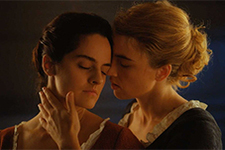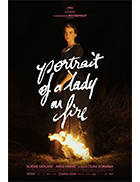Portrait of a Lady on Fire (Portrait de la jeune fille en feu)
|  Céline Sciamma’s Portrait of a Lady on Fire (Portrait de la jeune fille en feu) is a beautifully mounted drama about forbidden love that has every reason to be an intense emotional experience, but somehow never quite shakes free from its carefully designed and modulated aesthetic. Like Stanley Kubrick’s Barry Lyndon (1975), virtually every frame could be its own stand-alone art object, mounted and hung on a wall, and also like that film it visually reflects the painterly style of its era (which in this case is mid-18th century neoclassicism). However, while Kubrick’s rigid visual beauty merged with his film’s distanced and sometimes brutal sense of irony, Sciamma’s runs contrary to her desire to portray intense romantic emotion and physical desire played out over a tragically short period of time. The story takes place almost entirely on a small island off the course of Brittany, where a portrait artist named Marianne (Noémie Merlant) has been hired to paint a portrait of Héloïse (Adèle Haenel), the daughter of a wealthy family. Héloïse’s mother (Valeria Golino) has promised her hand in marriage to a nobleman in Milan, but Héloïse is reluctant to marry and has refused to pose because she knows that the resulting portrait will be used as an enticement to marriage. Marianne is instructed to act like she has been hired to be Héloïse’s companion while she secretly observes her so she can paint her portrait, a commission that requires her to gaze upon Héloïse and absorb the details of her being without being detected. In the process, Marianne and Héloïse fall in love, and when Héloïse’s mother leaves them alone in the family’s enormous manor for five days while Marianne attempts to complete a second portrait with Héloïse willingly posing, they are free to fully give in to their desire for each other. The only other person in the house is the maid, Sophie (Luàna Bajrami), who appears to be either oblivious to their relationship or doesn’t care, especially since she is dealing with an unwanted pregnancy that Marianne and Héloïse help her to terminate via an abortion by a local midwife. The abortion subplot plays an important role in binding the women together, allowing them to transcend normally rigid class lines, which makes the film more than just a poignant lesbian romance. There is much to admire in Portrait of a Lady on Fire, beginning with its sumptuous visual beauty, which Sciamma and cinematographer Claire Mathon conceive as a filmic meditation on neoclassical art and its evocation of idealized beauty. Perhaps to keep us focused on the imagery, Sciamma makes no use of nondiegetic music, instead favoring a heightened aura of natural sounds. Never before have the sounds of fabric rubbing against itself or paintbrushes stroking across a rough canvas felt so aurally intense. In stark contrast to those sounds is the frequent use of silence, which Sciamma employs liberally whenever characters are speaking; each line of dialogue is followed by a pregnant pause, which initially gives a sense of weight to everything that is said, but later begins to feel cumbersome and overly conspicuous. It also weighs down many of the interactions between Marianne and Héloïse that should otherwise be fraught with deep emotion, but instead feel staged and even, at times, contrived. And that is the primary problem with Portrait of a Lady on Fire. For all that is good about it, at virtually every turn it presents itself too obviously as an art object, rather than a human drama. There are tears and embraces and some carefully chosen moments of intense eroticism, but because so much of it feels staged and production designed and constructed, the passion remains abstract, rather than felt. The film is, not incidentally, at its best when it focuses on the nature and craft of painting and the ethereal labor of transposing physical reality into oil on canvas. Héloïse rejects Marianne’s first portrait, the one that she made while secretly observing her, because she feels that it does not reflect her and who she is; it lacks her true essence. Thus, the second painting, which is made with Héloïse’s consent and is created in the midst of their doomed affair, takes on an aura of authenticity, imbued as it is with Marianne’s growing knowledge of Héloïse not as a model to be painted, but as a person to be loved. Unfortunately, Adèle Haenel’s portrayal of Héloïse is often more petulant than it is intriguing; she is ostensibly defined by her anger at having her life ordered by others, but Haenel makes that anger sulky. She comes to life as she becomes involved with Marianne, who is a liberated woman with her own profession and the ability to take over her father’s business, thus freeing her from the need to marry. But, even then the film’s feminist ethos feels intellectual, rather than lived, with the characters acting as props in an overly familiar dramatization of desire and repression. It is beautiful, no doubt, but not much more—the cinematic essence of the kind of painting that Marianne seeks not to create. Copyright © 2020 James Kendrick Thoughts? E-mail James Kendrick All images copyright © Neon Pictures |
Overall Rating: 

 (2.5)
(2.5)


